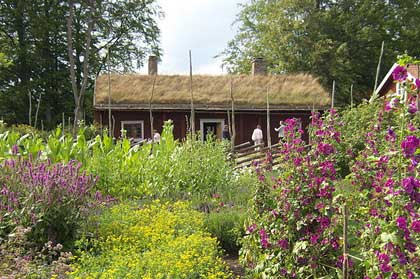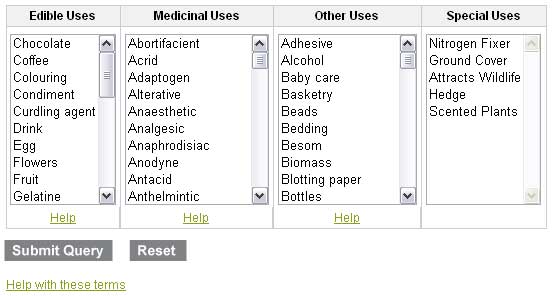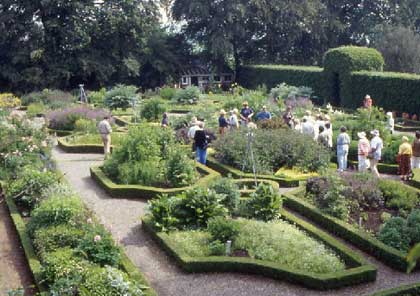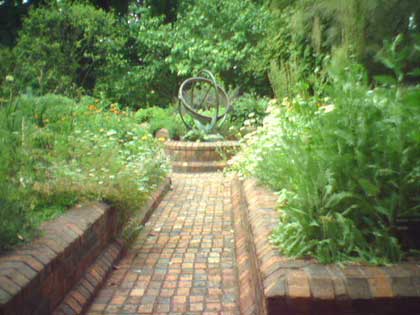Herb Gardens
Herb growing combines the delights of the flower garden with the productivity of the vegetable plot. The results are decorative, excellent in aroma and flavour, and inexpensive to produce
Herb gardens are among the oldest recorded gardens. Zingiber officinale is possibly the oldest known herb distributed during human migrations more than 6000 years ago. Some of the earliest herb gardens were planted over 4000 years ago in Egypt. Herb gardens were associated with temples, where herbs and sacred flowers were used for rituals and worship. These herbs included olives (Olea europaea ), pomegranate (Punica granatum ), frankincense (Boswellia sacra) - imported by Queen Hatsheput in d.1482BC - myrrh (Commiphora myrrha), cornflowers (Centaurea cyanus ), poppies (e.g.Papaver somniferum Papaver spp), mandrakes (e.g. Mandragora officinarum Mandragora spp), figs (e.g. Ficus carica Ficus spp), and lotuses (e.g. Nymphaea alba Nymphaea lotus). Chamomile (Chamaemelum nobile ) was used in an embalming oil for Rameses II in d.1224BC..

An informal herb garden
By definition, a herb is any plant that has culinary or curative uses. Nearly all the 7000 plants in the Plants For A Future database have edible or medicinal uses so you have lots of plants to choose from! There is a list of common herbs at the bottom of this page but we recommend you try some of the less common ones. The medicinal and edible ratings a long with a plants use will help you to decide. Don't forget to look at our pages Design Tips and Before You Start for more guidance if you need it. Herbs include: annuals, perennials, shrubs, and trees. The herb garden is often a separate space in the garden, devoted to growing a specific group of plants known as herbs. These gardens may be informal patches of plants, or they may be carefully designed.
Herb gardens may be purely functional, or they may include a blend of functional and ornamental plants. The herbs are usually used to flavour food in cooking, though they may also be used in other ways, such as discouraging pests, providing pleasant scents, or serving medicinal purposes (e.g., a physic garden), among others.
In the Database you can search for plant use using the 'Search By Use' section. See the image below:

For more information on how to use the database
The culinary use of herbs may result in positive medical side-effects. In addition, plants grown within the garden are sometimes specifically targeted to cure common illnesses or maladies such as colds, headaches, or anxiety. During the medieval period, monks and nuns developed specialist medical knowledge and grew the necessary herbs in specialist gardens. Now, especially due to the increase in popularity of alternative medicine, this usage is heavily increasing. Making a medicinal garden however, requires a great number of plants, one for each malady. Herbs grown in herb gardens are also sometimes used to make herbal teas.

A Formal Herb Garden
Examples of herbs used for specific purposes:
- Annual culinary herbs: basil, dill, summer savory
- Perennial culinary herbs: mint, rosemary, thyme, tarragon
- Herbs used for potpourri: lavender, lemon verbena
- Herbs used for tea: mint, lemon verbena, cannabis, chamomile, bergamot, Hibiscus sabdariffa (for making karkade).
- Herbs used for other purposes: stevia for sweetening, feverfew for pest control in the garden.
However, herbs often have multiple purposes. For example, mint may be used for cooking, tea, and pest control.

Common Herbs
Chives (Allium schoenoprasum )
Lemon verbena (Aloysia triphylla )
Dill (Anethum graveolens )
Angelica (Angelica archangelica )
Chervil (Anthriscus cerefolium )
Horseradish (Armoracia rusticana )
Southernwood (Artemisia abrotanum )
Wormwood (Artemisia absinthum )
French Tarragon (Artemisia dracunculus )
Borage (Borago officinalis )
Marigold (Calendula officinalis )
Caraway (Carum carvi )
Chamomile (Chamaemelum nobile )
Coriander (Coriandrum sativum )
Cumin (Cuminum cyminum )
Fennel (Foeniculum vulgare )
Woodruff (Galium odoratum )
Hyssop (Hyssopus officinalis )
Orris (Iris germanica florentina )
Bay (Laurus nobilis )
Lavender (Lavandula angustifolia )
Lovage (Levisticum officinale )
Lemon Balm (Melissa officinalis )
Mint (Mentha spicata )
Bergamot (Monarda didyma )
Sweet cicely (Myrrhis odorata )
Basil (Ocimum basilicum )
Marjoram (Origanum majorana )
Parsley (Petroselinum crispum )
Aniseed (Pimpinella anisum )
Rosemary (Rosmarinus officinalis )
Sorrel (Rumex acetosa )
Rue (Ruta graveolens )
Sage (Salvia officinalis )
Cotton lavender (Santolina chamaecyparissus )
Winter savory (Satureja montana)
Alecost (Tanacetum balsamita )
Feverfew (Tanacetum parthenium )
Common Thyme (Thymus vulgaris )
Oregano (Origanum vulgare )
(1).jpg)